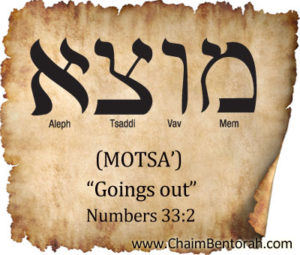HEBREW WORD STUDY – GOINGS OUT – MOTSA’ מוצא
Numbers 33:2: “And Moses wrote their goings out according to their journeys by the commandment of the LORD: and these [are] their journeys according to their goings out.”
 Numbers 33:2 gives a very profound statement. Moses wrote the goings out according to their journeys. The very fact he kept a journal is pretty amazing as writing was in its early infancy at this time. The earliest form of writings that have been recovered dating to the time of Moses would be the Amarna letters which are clay tablets written in the old Akkadian cuneiform which was the writing system of ancient Mesopotamia and used by all nations of that region including Egypt. This is the writing Moses would likely have been schooled in. If you ever go to a museum and see ancient writings that look like little triangles and lines on stone tablets, that is the cuneiform and most likely the form or writing that Moses used. The Akkadian is an early form of Canaanite which is the language family which would later evolve into its daughter languages of Hebrew and Phoenician. The earliest form of Hebrew or language that comes closest to Hebrew with its grammar is the Ugaritic. That is why you will find that I often reference a Hebrew word to its Semitic origins. I am taking it back to its Akkadian and Canaanite roots because of this the mother language from which Semitic languages including the Hebrew grew. We often see pictures of Moses with this huge stone tablet with a rounded top standing on a mountain surrounded by fire and lightning. Actually, if you Google the Amarna letters you will see a picture of what the ten commandments probably really looked like. Again, there is much, much debate on this so I am only giving you one theory.
Numbers 33:2 gives a very profound statement. Moses wrote the goings out according to their journeys. The very fact he kept a journal is pretty amazing as writing was in its early infancy at this time. The earliest form of writings that have been recovered dating to the time of Moses would be the Amarna letters which are clay tablets written in the old Akkadian cuneiform which was the writing system of ancient Mesopotamia and used by all nations of that region including Egypt. This is the writing Moses would likely have been schooled in. If you ever go to a museum and see ancient writings that look like little triangles and lines on stone tablets, that is the cuneiform and most likely the form or writing that Moses used. The Akkadian is an early form of Canaanite which is the language family which would later evolve into its daughter languages of Hebrew and Phoenician. The earliest form of Hebrew or language that comes closest to Hebrew with its grammar is the Ugaritic. That is why you will find that I often reference a Hebrew word to its Semitic origins. I am taking it back to its Akkadian and Canaanite roots because of this the mother language from which Semitic languages including the Hebrew grew. We often see pictures of Moses with this huge stone tablet with a rounded top standing on a mountain surrounded by fire and lightning. Actually, if you Google the Amarna letters you will see a picture of what the ten commandments probably really looked like. Again, there is much, much debate on this so I am only giving you one theory.
So much for the fluff and theory back to our study. Moses kept a record of the goings out which is likely where our first five books of the Bible had their origins. He kept this record for forty years. Even if written in cuneiform and clay tablets, that is a whole lot of writing. So you would think with all that writing some of these tablets would have been preserved. No, they were not. Could you imagine if they were? People would take pilgrimages to see them, worship them, touch them to get healed. God would never allow His word to degenerate to that level.
But why keep a record in the first place? The Midrash tells this story of a king who son was very ill and took him on a journey, a “going out”, to be healed. The king kept a journal of their “going out” and upon their return, they shared the story of their adventure. “This is where we slept, here we caught a cold, here your head hurt.” There were stories of bonding, joy, as well as failure and disappointment. All which reflected a father’s love for his child and all preserved for the child to read and cherish as he grew older.
The word going out in Hebrew is motsa’ which is a word used to describe the flowing of a stream of water from its origin to the place where one is able to scoop it up and be refreshed. That water had to travel through many cracks and crevices through rocks and stones to reach you. Just as the children of Israel had to travel through many hard times, joyous times, failures and disappointments to reach the promised land, so too must we journey through this life filled with hard times, joyous times, failure and disappointments to reach our promised land in the eternal arms of Jesus. Like the king and his son, it is a “going out” of a loving Heavenly Father bonding with His children.
.







Recent Comments